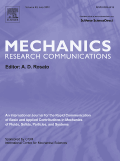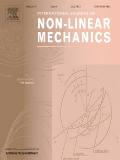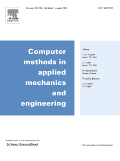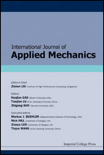
MECHANICS RESEARCH COMMUNICATIONS
Scope & Guideline
Pioneering Research in Mechanics and Material Science
Introduction
Aims and Scopes
- Theoretical and Computational Mechanics:
Focus on the development of new theoretical frameworks and computational methods for solving complex mechanical problems, including finite element analysis, multiscale modeling, and homogenization techniques. - Experimental Mechanics:
Publication of studies that involve experimental investigations of mechanical phenomena, including material characterization, failure analysis, and dynamic behavior under various loading conditions. - Advanced Materials and Structures:
Research related to the mechanics of advanced materials such as metamaterials, composites, and architected materials, exploring their unique mechanical properties and applications. - Nonlinear Dynamics and Stability:
Studies on the nonlinear dynamics of mechanical systems, including bifurcation analysis, stability assessments, and chaos theory in various engineering applications. - Biomechanics and Biological Applications:
Exploration of mechanical principles in biological systems, focusing on the mechanical behavior of biological tissues, cells, and biomaterials. - Interdisciplinary Applications:
Integration of mechanics with other fields such as fluid dynamics, thermodynamics, and materials science to address complex engineering challenges.
Trending and Emerging
- Metamaterials and Architected Materials:
There is a growing interest in the mechanics of metamaterials and architected materials, emphasizing their unique properties and potential applications in engineering, such as vibration control and energy absorption. - Multiscale and Homogenization Methods:
Recent publications reflect a trend towards multiscale modeling approaches that bridge different scales, from microstructural to macroscopic behavior, allowing for more accurate predictions of material performance. - Dynamic and Nonlinear Analysis:
A notable increase in research focused on dynamic and nonlinear analysis methods, including studies on chaos, bifurcation, and stability, indicating a shift towards understanding complex mechanical behaviors. - Bio-inspired and Soft Robotics:
Emerging themes in bio-inspired design and soft robotics highlight the application of mechanical principles to soft materials and structures, which are crucial for developing adaptive and flexible systems. - Data-driven and Machine Learning Approaches:
The integration of machine learning techniques in mechanics research is gaining traction, with studies focusing on data-driven methodologies for predictive modeling and optimization in mechanical systems.
Declining or Waning
- Classical Elasticity and Plasticity:
Traditional studies on classical elasticity and plasticity appear to be less prominent in recent publications, possibly due to the increasing focus on advanced materials and complex mechanical behaviors that demand more sophisticated modeling approaches. - Linear Theory Applications:
Research centered on linear theories and their applications has seen a decrease, as researchers increasingly explore nonlinear phenomena and complex interactions in mechanical systems. - Static Analysis of Structures:
The focus on static analysis methods for structures, while still relevant, has waned in favor of dynamic analysis and real-time applications, especially in the context of structural health monitoring and adaptive systems.
Similar Journals

MECCANICA
Illuminating Pathways in Engineering ResearchMECCANICA, an esteemed journal published by Springer, stands at the forefront of research in the fields of Condensed Matter Physics, Mechanical Engineering, and Mechanics of Materials. Established in 1966 and continuing through 2024, this journal provides a robust platform for the dissemination of innovative research and advancements in these increasingly interconnected domains. With an impressive 2023 ranking placing it in the Q2 category across multiple fields, MECCANICA boasts a Scopus rank of #198 in Mechanical Engineering, #150 in Condensed Matter Physics, and #141 in Mechanics of Materials, highlighting its significance and influence within the scholarly community. The journal aims to foster dialogue among researchers, professionals, and students, facilitating the exchange of cutting-edge ideas and methodologies crucial for overcoming contemporary engineering and physics challenges. Readers can access a wealth of knowledge through its comprehensive articles, and while it does not currently offer open access, the journal remains instrumental in shaping the future of engineering and physical sciences.

INTERNATIONAL JOURNAL OF NON-LINEAR MECHANICS
Fostering Excellence in Mechanical Engineering ResearchWelcome to the International Journal of Non-Linear Mechanics, a premier publication dedicated to advancing the understanding of non-linear behavior in mechanical systems. Published by Pergamon-Elsevier Science Ltd, this esteemed journal has been an influential platform since its inception in 1966 and continues its rigorous exploration of specialized topics until 2024. With a strong focus on applied mathematics, mechanical engineering, and mechanics of materials, it holds an impressive Q1 ranking in both mechanical engineering and mechanics of materials, and a Q2 ranking in applied mathematics, underscoring its significance in these fields. Notably, it ranks 81st out of 635 in Applied Mathematics, highlighting its vital contribution to the literature. The journal's commitment to quality research is reflected in its indexing in Scopus and its prominent impact within the academic community. Although not an open access journal, it remains accessible to researchers and professionals seeking cutting-edge innovations and breakthroughs in non-linear mechanics. We invite scholars, practitioners, and students alike to engage with the pivotal research published in this journal as they advance their own works in the dynamic landscape of engineering and applied sciences.

MECHANICS OF ADVANCED MATERIALS AND STRUCTURES
Advancing the frontiers of materials science and structural engineering.Mechanics of Advanced Materials and Structures is a distinguished journal published by Taylor & Francis Inc, focusing on the innovative fields of Civil and Structural Engineering, Materials Science, Mechanical Engineering, and Mechanics of Materials. With ISSN 1537-6494 and E-ISSN 1537-6532, this journal is positioned within the Q2 quartile rankings of its categories, demonstrating its significant scholarly impact. It has been a pivotal platform since its inception in 1997, providing researchers and professionals with comprehensive insights and the latest findings, until the expected closure in 2024. Situated in the United Kingdom, the journal is dedicated to enhancing the understanding of complex materials and structural behavior through rigorous peer-reviewed articles. Its high visibility in Scopus rankings further underscores its importance, making it an essential resource for those engaged in advanced materials research and structural analysis. With options for open access, the journal ensures broad dissemination of knowledge, fostering a collaborative environment for researchers, practitioners, and students alike.

COMPUTER METHODS IN APPLIED MECHANICS AND ENGINEERING
Transforming Theoretical Insights into Practical Applications.COMPUTER METHODS IN APPLIED MECHANICS AND ENGINEERING, published by Elsevier Science SA, is a premier journal that has significantly contributed to the fields of computational mechanics, computer science applications, mechanical engineering, and the mechanics of materials since its inception in 1972. With an ISSN of 0045-7825 and an E-ISSN of 1879-2138, this journal is recognized for its rigorous peer-review process and is consistently ranked in the Q1 quartile across multiple categories, including Computational Mechanics and Mechanical Engineering. Its impressive Scopus rankings place it in the top tiers of its field, with a percentile ranking of 98th in Computational Mechanics. Researchers, professionals, and students will find the journal's comprehensive scope and high-quality articles invaluable for advancing their knowledge and practices at the intersection of engineering and computation. Although not an open-access journal, its impactful contributions to both theoretical and applied research make it an essential resource for anyone involved in these dynamic fields.

Materials Physics and Mechanics
Unlocking the Secrets of Material BehaviorMaterials Physics and Mechanics is a pivotal journal dedicated to advancing the fields of condensed matter physics, materials science, mechanical engineering, and the mechanics of materials. Published by the Institute of Problems in Mechanical Engineering, Russian Academy of Sciences, this journal has established itself as a valuable resource since its inception, particularly from 2003 to 2004 and now continuously from 2009 to 2024. Although it currently holds a Q4 categorization in various disciplines, its contributions are critical to understanding and developing new materials and their applications in engineering. The journal provides insightful articles that explore the nuances of material properties, their behaviors under different conditions, and the physical principles governing these phenomena. Though it operates under a traditional publication model, the insights provided within its pages are invaluable to researchers, professionals, and students striving to push the boundaries of knowledge in the materials domain. Its ISSN numbers (1605-2730, E-ISSN 1605-8119) serve as a gateway to a wealth of scientific knowledge emanating from the Russian Federation, contributing to the global discourse in materials physics and mechanics.

Journal of Computational Applied Mechanics
Fostering Innovation in Applied Mechanics ResearchJournal of Computational Applied Mechanics, published by UNIV TEHRAN, DANISHGAH-I TIHRAN, is an influential open-access journal that has been disseminating significant research findings since its inception in 2012. With a dedicated focus on the fields of Computational Mechanics, Mechanical Engineering, and Mechanics of Materials, this journal has garnered a Q3 ranking in multiple relevant categories as of 2023, indicating its burgeoning impact within the academic community. Although precise HIndex scores are currently unavailable, the journal's recognition is underscored by its Scopus rankings, placing it in the middle tier among its peers. The journal invites researchers, professionals, and students to contribute to and engage with the continually evolving discourse in applied mechanics, fostering innovation through the dissemination of quality research. As an open-access journal, it ensures that findings are readily accessible to a global audience, thereby enhancing collaboration and knowledge sharing in the scientific community.

International Journal of Applied Mechanics
Shaping the Future of Applied Mechanics ScholarshipThe International Journal of Applied Mechanics, published by World Scientific Publishing Co Pte Ltd, is a premier platform that serves the fields of materials science, mechanical engineering, and mechanics of materials. Located in Singapore, this journal has established itself as a crucial resource for researchers, professionals, and students, with its convergence of scholarly work from 2009 to 2024. Ranked in the Q2 category across notable disciplines, including Materials Science, Mechanical Engineering, and Mechanics of Materials, it reflects a strong commitment to publishing high-quality research that pushes the boundaries of knowledge in applied mechanics. Despite being a non-open access journal, its successful Scopus rankings, including an impressive rank of #151 in Mechanical Engineering, signify its substantial impact and recognition within the academic community. This journal not only aims to disseminate pioneering research but also to foster collaboration and innovation in the rapidly evolving landscape of applied mechanics.

CONTINUUM MECHANICS AND THERMODYNAMICS
Navigating the Challenges of Continuum Mechanics and ThermodynamicsCONTINUUM MECHANICS AND THERMODYNAMICS is a prestigious academic journal published by Springer, focusing on the interdisciplinary fields of mechanics, materials science, and thermodynamics. With an ISSN of 0935-1175 and E-ISSN 1432-0959, this journal serves as an essential platform for researchers and practitioners to disseminate innovative findings and methodologies that advance theoretical and practical applications in these pivotal areas of science. Operating from Germany, this journal has gained significant recognition, achieving a Q2 quartile ranking in multiple categories, including Materials Science and Mechanics of Materials, as noted in the 2023 metrics. With Scopus rankings highlighting its competitive standing—ranked #65 in General Physics and Astronomy and #118 in Mechanics of Materials—CONTINUUM MECHANICS AND THERMODYNAMICS is committed to publishing high-quality, peer-reviewed research that fosters knowledge exchange and drives progress. While it currently does not offer Open Access, this journal remains a vital resource for those committed to exploring the complexities of continuum mechanics and thermodynamic processes.

COMPUTATIONAL MECHANICS
Unveiling New Horizons in Computational MechanicsCOMPUTATIONAL MECHANICS, published by SPRINGER, is a premier international journal that focuses on the intersection of applied mathematics, engineering, and computational methods. With a commendable Q1 ranking in multiple categories, including Applied Mathematics and Mechanical Engineering, this journal is pivotal for disseminating groundbreaking research and innovative methodologies that advance the field. The journal has steadily contributed to the academic community since its inception in 1986 and continues to lead discussions and practices in computational mechanics and related disciplines. With a robust impact reflected in its Scopus rankings—placing it within the top percentiles across various categories—COMPUTATIONAL MECHANICS serves as a crucial platform for researchers, professionals, and students seeking to explore and contribute to significant advancements in computational theory and mathematical applications. Although it does not currently operate under an open access model, the journal ensures wide accessibility through libraries and institutional subscriptions, fostering a rich exchange of knowledge in the global scientific community.

STRENGTH OF MATERIALS
Illuminating the path of material performance analysis.STRENGTH OF MATERIALS is a prestigious journal published by SPRINGER that focuses on the critical field of mechanics of materials, providing an authoritative platform for the dissemination of research and developments in material strength analysis since 1969. With an ISSN of 0039-2316 and an E-ISSN of 1573-9325, this journal serves a global audience of researchers, professionals, and students, contributing essential insights into the physical properties and performance characteristics of various materials under stress and strain. As part of the United States' academic literature, it showcases work that not only advances theoretical knowledge but also applies to practical engineering scenarios. Although ranked in the Q4 tier with respect to its category in Mechanics of Materials, with a Scopus rank of #319 out of 398 (19th percentile), it remains an important resource for those looking to expand their understanding in this specialized area. Researchers can access a wealth of information through this journal, fostering continued innovation and interdisciplinary collaboration.